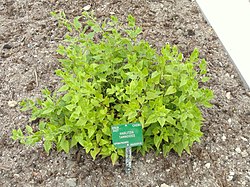This article has multiple issues. Please help improve it or discuss these issues on the talk page . (Learn how and when to remove these messages)
|
| Hablitzia | |
|---|---|
 | |
| Scientific classification | |
| Kingdom: | Plantae |
| Clade: | Tracheophytes |
| Clade: | Angiosperms |
| Clade: | Eudicots |
| Order: | Caryophyllales |
| Family: | Amaranthaceae |
| Subfamily: | Betoideae |
| Tribe: | Hablitzieae |
| Genus: | Hablitzia M.Bieb. (1817) |
| Species: | H. tamnoides |
| Binomial name | |
| Hablitzia tamnoides M.Bieb. (1817) | |
Hablitzia tamnoides, or Caucasian spinach, the sole species in the genus Hablitzia, is an edible herbaceous perennial plant, native to the Caucasus region. It is in the family Amaranthaceae and the subfamily of Betoideae . It is related to the genus Beta , but unlike Beta, it is a vine. [1] It is also likely one of the longest lived plants in its family - one plant growing in Norrtälje, Sweden is reported to be over 50 years old.[ citation needed ]




